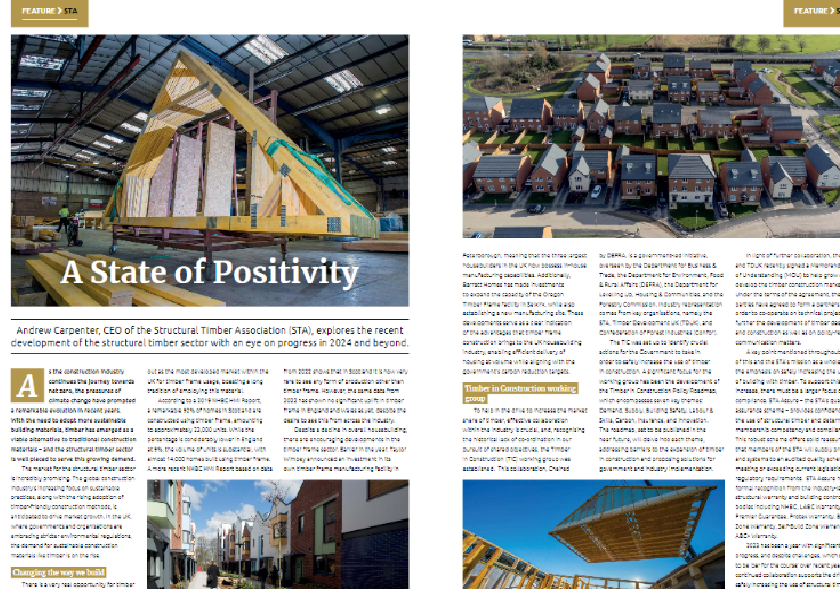The positive state of the structural timber industry
04/12/2023

As the construction industry continues the journey towards Net Zero, the pressures of climate change have prompted a remarkable evolution in recent years. With the need to adopt more sustainable building materials, timber has emerged as a viable alternative to traditional construction materials – and the structural timber sector is well placed to serve this growing demand. Here, Andrew Carpenter, CEO of the Structural Timber Association, explores the development of the structural timber sector and provides insights into its outlook for the future.
The market for the structural timber sector is incredibly promising. The global construction industry’s increasing focus on sustainable practices, along with the rising adoption of timber-friendly construction methods, is anticipated to drive market growth. In the UK, where governments and organisations are embracing stricter environmental regulations, the demand for sustainable construction materials like timber is on the rise.
There is a very real opportunity for timber frame construction to gain a larger share of the housing market in the UK. Scotland stands out as the most developed market within the UK for timber frame usage, boasting a long tradition of employing this material.
According to a 2019 NHBC HMI Report, a remarkable 92% of homes in Scotland are constructed using timber frame, amounting to approximately 23,000 units. While the percentage is considerably lower in England at 9%, the volume of units is substantial, with almost 14,000 homes built using timber frame. A more recent NHBC HMI Report based on data from 2022 shows that in Scotland it is now very rare to see any form of production other than timber frame. However, the same data from 2022 has shown no significant uplift in timber frame in England and Wales as yet, despite the desire to see this from across the industry.
Despite a decline in overall housebuilding, there are encouraging developments in the timber frame sector. Taylor Wimpey, earlier in the year, announced an investment in its own timber frame manufacturing facility in Peterborough means that the three largest housebuilders in the UK now possess in-house manufacturing capabilities. Additionally, Barratt Homes has made investments to expand the capacity of the Oregon Timber Frame facility in Selkirk, while also establishing a new manufacturing site. These developments serve as a clear indication of the advantages that timber frame construction brings to the UK housebuilding industry, enabling efficient delivery of housing at volume while aligning with the government’s carbon reduction targets.
To help in the drive to increase the market share of timber, effective collaboration within the industry is crucial, and, recognising the historical lack of coordination in our pursuit of shared objectives, the Timber in Construction (TiC) working group was established. This collaboration, Chaired by DEFRA, is a government-led initiative, overseen by the Department for Business & Trade, the Department for Environment, Food & Rural Affairs, the Department for Levelling Up, Housing & Communities, and the Forestry Commission. Industry representation comes from key organisations, namely the Structural Timber Association (STA), Timber Development UK (TDUK), and Confederation of Forest Industries (Confor).
The TiC was set up to identify crucial actions for the Government to take in order to safely increase the use of timber in construction. A significant focus for the working group has been the development of the Timber in Construction Policy Roadmap, which encompasses seven key themes: Demand, Supply, Building Safety, Labour & Skills, Carbon, Insurance, and Innovation. The roadmap, set to be published in the near future, will delve into each theme, addressing barriers to the expansion of timber in construction and proposing solutions for government and industry implementation.
In light of further collaboration, the STA and TDUK has signed a Memorandum of Understanding (MOU) to help grow and develop the timber construction market. Under the terms of the agreement, the two parties have agreed to form a partnership in order to cooperate on technical projects to further the development of timber design and construction as well as on policy-related communication matters.
A key point mentioned throughout this piece, and the STA’s mission as a whole, is the emphasis on safely increasing the use of building with timber, and to support this increase, there must be a larger focus on compliance. STA Assure, the STA’s quality assurance scheme, provides confidence in the use of structural timber and determines membership competency and compliance. This robust scheme offers solid reassurance that members of STA will supply products and systems to an audited quality scheme, meeting or exceeding current legislation and regulatory requirements.
STA Assure has formal recognition from the industry-leading structural warranty and building control bodies including NHBC, LABC Warranty, Premier Guarantee, Protek Warranty, Build-Zone Warranty, Self-Build Zone Warranty and ABC+ Warranty.
2023 has been a year with significant progress, and despite challenges, which seem to be ‘par for the course’ over recent years, the continued collaboration supports the drive for safely increasing the use of structural timber.
To read the feature click here